 Battling
a Grandmaster! Battling
a Grandmaster!
It's Deep Boris! For the few years that KasparovChess.com
was in existence I had the pleasure of working with Israeli Grandmaster
Boris Alterman. The former Soviet star was in the top 100 when he played
regularly and is still a tough match for anyone, although he rarely plays
in tournaments these days.
 Alterman
was certainly more than a match for me (Mig) during our office blitz matches.
I managed to pick up the rare win or draw against just about every other
titled player in the Israeli office blitz tournaments. But I don't remember
ever scoring against Deep Boris, a nickname he acquired from working with
the programmers of the Junior (and Deep Junior) computer program. Alterman
was certainly more than a match for me (Mig) during our office blitz matches.
I managed to pick up the rare win or draw against just about every other
titled player in the Israeli office blitz tournaments. But I don't remember
ever scoring against Deep Boris, a nickname he acquired from working with
the programmers of the Junior (and Deep Junior) computer program.
Boris plays typical simul chess in this game
against our reader hero. He isn't interested in sharp tactics when a clear
and simple advantage is available without much calculation. The big positional
plus he gets for free in the opening is more than enough.
The result is a positional master class from
the Grandmaster and not a lot of fun for White. But Alphonse battles on
and gets the most from the lesson. His entertaining notes (in green)
are instructive even when misguided in a few cases!
Replay the game with annotations online
here.
Alphonse (1547) - GM Boris Alterman
[Alphonse; Mig; Fritz 8]
Alphonse:
Here is a game I played against GM Boris Alterman in a 35+ board simul
yesterday online. I used Fritz to help analyze my moves and have specified
which comments are mine and which are Fritz's. I thought it would be an
interesting submission, at least for me, as it's one of the very few games
I've analyzed through Fritz where I haven't been awarded the black tactical
blunder medal. :-)
1.c4 e5 2.g3 Nf6 3.Bg2 d5 (D1)
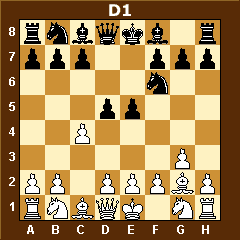 Alphonse:
As has been suggested, I spend barely any time on studying openings. Needless
to say, I did read Tony Kosten's "The Dynamic English" about
a year and a half ago and have played the English ever since. Alphonse:
As has been suggested, I spend barely any time on studying openings. Needless
to say, I did read Tony Kosten's "The Dynamic English" about
a year and a half ago and have played the English ever since.
My repertoire is quite simple. With White, always 1.c4.
As Black, 1...Nf6 against d4 and c4 and 1...g6 against e4. This move,
however, took me out of my "book" and forced me to start thinking
on my own.
4.cxd5 Nxd5 5.e4? (D2)
|
|  Alphonse:
Whoops! At the time, this seemed like a great move. I would get my center
pawn and even better, make my opponent waste time by moving his Knight
twice. This move looked so perfect in theory, that I didn't think twice
about it. Fritz points out the vicious tactic. Alphonse:
Whoops! At the time, this seemed like a great move. I would get my center
pawn and even better, make my opponent waste time by moving his Knight
twice. This move looked so perfect in theory, that I didn't think twice
about it. Fritz points out the vicious tactic.
Mig: If this
move looks good to you, we have more problems than vicious tactics! There
are two or three reasons why this is a horrible move, apart from the fact
that it comes close to losing instantly.
First, it blocks in the active g2 bishop. Why go to all
the trouble to fianchetto the bishop and then block its diagonal? Two,
the e4 pawn would be usefully directed at preventing central expansion
by Black, for example stopping ..d5. But Black has already played ..d5
so the pawn doesn't really do much at all.
Three, this move creates a massive hole on the d3 and
d4 squares. d3 is particularly bad because Black can exploit this immediately
with 5...Nb4. These are more subtle positional considerations, but they
are important ones. Don't block in your own pieces unless you are confident
you can free them soon.
The bishop on g2 has little hope of escape because the
e4 pawn isn't going anywhere anytime soon. Don't create big holes in your
position. A hole is a square that cannot be protected by a pawn. After
5.e4 there are holes on d3 and d4. Combined with the relatively slow development
plan of g3-Bg2, this allows Black to grab the advantage on move 5!
Conversely, look for holes in the enemy position and try
to exploit them. It is interesting that my old friend GM Boris Alterman
doesn't do this here, but when giving a simultaneous exhibition it's best
to be cautious if you're not 100% sure of the complications.
5...Nb6? Mig:
Black misses a chance to gain a decisive advantage by playing against
the hole on d3 with 5..Nb4!. Still, the weakness of d3 and d4 is PERMANENT,
an important consideration. Pawn moves are forever, they can't go back!
Black has all the time in the world to exploit this structural
weakness, unless White can enforce the d4 push to eliminate his backwards
d-pawn. A backwards pawn is one that cannot be protected by other pawns
and cannot easily advance. The concept of permanent advantages (and weaknesses)
is the key to understanding structural play.
Black has a significant advantage in this position because
the g2 bishop has no scope and the weaknesses of d2, d3, and d4.
[Fritz 8: >=5...Nb4 Black has the better game 6.d4
(6.Bf1?! N8c6) 6...Qxd4 7.Qxd4 Nc2+ 8.Kd1 Nxd4-+ (8...exd4? 9.Kxc2
Nc6 10.Bh3+-) ]
6.Nf3 Nc6 7.0-0 Alphonse:
I thought I had a nice setup and *felt* as if I had the advantage. Fritz
says Black has a strong advantage here (-0.78 if I play the next six moves
perfectly) though I'm not sure why. I do eventually lose the game, but
is it so obvious at this point?
Mig: Don't
get carried away with computer evaluations unless they are quite high.
Less than a pawn (1.00 in computerspeak) is often too subtle for a computer
program to understand. But here Fritz is right for the reasons we mentioned
above. Your backwards d-pawn is in for a very hard life and Black has
no compensating weakness of his own.
7...Bc5 Mig:
Hitting d4 again and also eyeing the king. 8.Qc2 (D3)
|
 Alphonse:
Cool! Yet another opening move with tempo! Sure, he's not going to hang
the Bishop, but now he has to do something to protect it. Plus, I thought
I could now protect both d2 and e4. Alphonse:
Cool! Yet another opening move with tempo! Sure, he's not going to hang
the Bishop, but now he has to do something to protect it. Plus, I thought
I could now protect both d2 and e4.
Mig: True,
developing with tempo is cool. Black defends with tempo though, developing
his queen and defending the bishop at the same time. Meanwhile, c2 is
a vulnerable square for the queen. It can be attacked by a knight from
b4 and d4.
8...Qe7 9.d3 Alphonse:
Now I realized that my Queen was in a lousy spot. d4 could not be played
play nor with eventual backup because I had given up control of my side
of the d-file. Plus, it did not seem like a good idea to take my Rook
away from guarding the f-pawn and stick it on the d-file.
9...0-0 10.Nbd2 Alphonse:
Development time. I didn't want to put the Knight on c3 since it would
take my pressure off of the Bishop at c5. To me, it looked like his Queen
was "pinned" to the a3-f8 diagonal since, for now, she was the
only protection the Bishop had.
Plus, I really wanted to see my Knight on c4 helping to
attack the e5 pawn and taking it there via a3 didn't seem as good as via
d2. Fritz doesn't like this move at all, and I guess that's because it
blocks my Bishop? Anyway, I also came up with a plan, and that was to
mobilize everything I had, beginning with my Queen's Knight, against the
e4 pawn. I saw, Nc4, b2-b3, Bb2, Rad1, Qd2, and finally d4.
Mig: All right,
a man with a plan! I'm not sure what hope there is against e5 when Black
can always defend it with ..f6. Mobilization is always good of course.
It's not that this move is so bad, but it allows ..Nb4, attacking the
queen and d3 at the same time, which is very strong for Black. Lucky for
White Alterman continues to play routinely. [Fritz 8: 10.a3 Rd8=/+]
10...Bg4 (D4)
|
|  Mig:
The GM is playing for a clear, simple advantage instead of worrying about
punishing White's mistakes immediately. This move prepares to capture
the knight, which is the only piece defending the key d4 square. After
he captures he will drop a knight on d4 with total domination. Mig:
The GM is playing for a clear, simple advantage instead of worrying about
punishing White's mistakes immediately. This move prepares to capture
the knight, which is the only piece defending the key d4 square. After
he captures he will drop a knight on d4 with total domination.
[10...Nb4 11.Qb1-/+] 11.Nc4
[Fritz 8: >=11.Nb3!? Alphonse:
I never thought of using the Knight to pressure the Bishop. Only using
the Knight to pressure the e5-pawn.
Mig: This isn't
really to pressure the bishop, although it gains time by doing so, but
to control the d4 square if the f3 knight is removed. 11...Bxf3 12.Qxc5=/+]
11...Bxf3-/+ 12.Bxf3 Nd4 13.Qd1 Nxc4 14.dxc4
(D5)
|
 Mig:
Black has removed the weak white d-pawn, but has gained compensation.
After the exchanges White has been left with a miserable bishop on f3
that has little hope of ever living a full life. The pawns on c4 and e4
block its best diagonals. Mig:
Black has removed the weak white d-pawn, but has gained compensation.
After the exchanges White has been left with a miserable bishop on f3
that has little hope of ever living a full life. The pawns on c4 and e4
block its best diagonals.
Black has an incredibly strong knight on d4; it dominates
the board. White might be able to trade it for his dark-squared bishop
with Be3-Bxd4, but a black bishop on d4 will be almost as strong as the
knight is. Imagine the position with the white bishop stuck behind its
own pawns and black bishop powerfully posted on d4.
It's also worth having a discussion here about the importance
of Black having control of the piece that blockades the only open file,
the d-file. Both sides can build up on the file, putting their rooks on
it. Then it will be Black who will decide exactly when to open the file
by moving his knight (or bishop, if it's on d4).
14...Rad8 15.Bg2 Mig:
Black has no good discovered attacks with the knight since all of its
forward squares are covered by the queen.
15...c6 Alphonse:
This move really puzzled me. I try to figure out what my opponent is doing
and this move left me without a clue. In hindsight, I'm thinking it may
have something to do with fighting for control over the d5-square?
Mig: Definitely
a subtle move from the GM, who doesn't see any way to move forward directly
and so improves his own position while waiting for a mistake. I've played
many games against Alterman and he is tremendous at this sort of play.
He's not interested in blowing you up when you can slowly
push you off the board with almost no risk! ..c6 is not a pointless waiting
move, however. It protects the b7 square in several lines in which Black
opens up an attack with ..f5 and the g2 bishop's diagonal will be opened.
16.Be3 (D6)
|
| 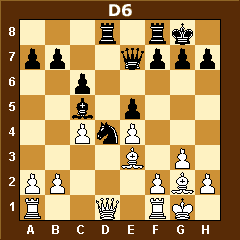 Alphonse:
Now I'm thinking about pressuring the Bishop as I noticed I could attack
him indirectly while at the same time developing mine. But, sorry to say,
I also didn't see any better place for him. Alphonse:
Now I'm thinking about pressuring the Bishop as I noticed I could attack
him indirectly while at the same time developing mine. But, sorry to say,
I also didn't see any better place for him.
I also didn't want to move my Queen since I was afraid
that sticking her on a4 would leave her offside and that g4 or h5 would
just give my opponent the chance to gain more than one tempo by chasing
her around with pawns.
Mig: Not a
bad square necessarily, and it has the threat of capturing the mighty
knight. Alphonse might be right when he says moving his queen to the kingside
won't achieve much, but the reasoning is faulty.
You WANT your opponent to weaken his king by chasing your
queen around with pawns. You can't have a successful attack unless you
create weaknesses in the enemy position. With all the protecting pawns
on their original squares the black king is safer than a bottle of water
in a French wine shop.
16...Ne6 Mig:
No, you can't have my lovely knight! And if the dark-squared bishops are
exchanged the knight can come back and be completely immune to attack.
17.Bxc5 Mig:
This is too cooperative. There's not much to be about the exchange of
bishops but why help Black by putting the queen on the powerful c5 square?
Make Black do the work and spend a tempo to capture. Note that if Black
captures BxB on e3, White can recapture with the f-pawn, which will keep
the knight out of d4. The doubled pawns will be ugly, but things would
be worse with a knight on d4.
[Alphonse:
17.Qg4 Bxe3 18.fxe3 Qc5 x c4, e3; 17.Qe2 Bxe3 18.fxe3]
17...Qxc5 [17...Rxd1?? 18.Bxe7 Rxa1 19.Rxa1] 18.Qg4
(D7)
|
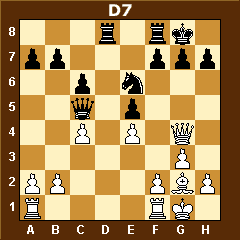 Alphonse:
I really thought that this was not only the only place for my Queen, but
also a way to be able to make some sort of progress with Kh1 followed
by f2-f4. Alphonse:
I really thought that this was not only the only place for my Queen, but
also a way to be able to make some sort of progress with Kh1 followed
by f2-f4.
Fritz says I should have moved to the queenside instead,
but I thought that a GM would certainly know how to punish me for trying
to gobble pawns.
Mig: Forget
gobbling them, what about the pawn on c4?! Material is material after
all. Qb3 at least protects the c4 pawn even if you don't capture on b7.
[Fritz 8: 18.Qb3 Nd4 19.Qxb7 a5-/+ Alphonse:
I still don't care for this as now my Queen has no way to help in any
de fence of my center pawns or my kingside.]
18...Rd2 [18...Qxc4 Mig:
There's no reason not to take this pawn, but Alterman continues to play
for domination. Eventually the white position will crack to pieces.]
19.Kh1?? (D8)
|
|  Alphonse:
Stupid...just stupid. I can't even blame this one on zeitnot or my kids
or my dogs howling in the background. I saw an immediate crisis taking
place on f2 and g2 and felt that breaking the pin along the g1-a7 diagonal
was more important than a pawn. Alphonse:
Stupid...just stupid. I can't even blame this one on zeitnot or my kids
or my dogs howling in the background. I saw an immediate crisis taking
place on f2 and g2 and felt that breaking the pin along the g1-a7 diagonal
was more important than a pawn.
In hindsight, and Fritz agrees, better was a calm b3
as I was in no immediate danger. Fritz moves Black from the strong advantage
column to the winning column with this beauty of mine. The question mark
is also mine.
Mig: A pure
and simple blunder that gives away a full pawn for nothing at all. I added
another question mark! But don't think that White wasn't lost already.
It would have taken awhile, but Black's domination of
the board is nearly complete even after b3. Black will double rooks on
the d-file and play his knight to the d4 square. [Fritz 8: >=19.b3!?-/+
]
19...Rxb2-+ Mig:
The f2 pawn was also available, but removing the b-pawn means the c-pawn
won't be able to be defended.
20.f4 Alphonse:
Now, the word counterplay came to mind. Silly me. Ten moves from here,
I would find myself wishing badly for that pawn to be back on f2.
Mig: Nah, go
for it! White is losing by position and losing by material. Sitting around
waiting for the GM to clean up isn't going to be interesting at all. Desperate
measures rarely work but they are better than nothing.
As we often say around here, a 95% chance of a quick
loss with a tiny ray of hope is better than a 100% chance of a slow death
with no counterchances. GIVE YOUR OPPONENT A CHANCE TO MAKE A MISTAKE.
If passive defense in a bad position has no chance of success (like here),
you might as well throw the kitchen sink.
20...Rd8?! Mig:
A bit of a slip by the GM since now White's desperation attack can get
a little something going with f5-f6. It won't work in the long run but
it's more than he should allow in such a dominating position. [20...Nd4
21.Rfc1-+]
21.Rad1? (D9)
|
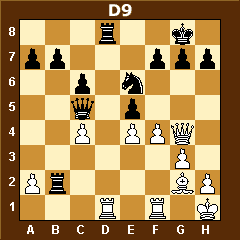 Alphonse:
I thought I had to do something to challenge both Rooks coming at me on
the 2nd rank. Now, I wish I had taken advantage of the opportunity to
at least give my king a little play in case this game actually made it
as far as an endgame. Alphonse:
I thought I had to do something to challenge both Rooks coming at me on
the 2nd rank. Now, I wish I had taken advantage of the opportunity to
at least give my king a little play in case this game actually made it
as far as an endgame.
[Fritz 8: 21.f5 Nf8-+ 22.f6 g6 23.Qh4 Qxc4 24.Qh6 Ne6
Mig: Black
has everything defended, but at least he had to think a little.
Alphonse:
21.Rg1 Rdd2 22.h4? intending Kh2]
21...Rxd1-+ 22.Qxd1
Alphonse:
It did not seem exceptionally bad to recapture with the Queen. The a2-
or c2-pawns were going to fall anyway, and it seemed like a better idea
to have my Queen around to help out in case he would eventually get his
Queen on to the 2nd rank and start pushing his queenside pawns.
Mig: Not exceptionally
bad, but taking with the rook would have given White two active pieces
instead of one. [Fritz 8: 22.Rxd1 Qxc4 23.f5 Qc2-+; 22.Rxd1 Rxa2 23.f5
Qf2-+]
22...Qd4 [22...Qxc4!? 23.a4 Qe2 24.Qxe2 Rxe2
25.Rb1-+]
23.Qc1?
Alphonse:
The question mark here is Fritz'. I thought I was doing a nice job bringing
my Queen into the de fence, protecting the c4- and f4-pawns, and giving
the Rook some assistance. [Fritz 8: 23.fxe5 Qxc4 24.Qh5 Nf8-+]
23...Qd2 24.Rg1? (D10)
|
| 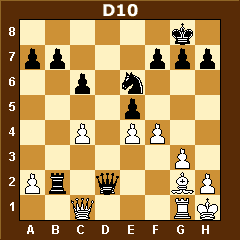 Alphonse:
This is another move that seemed just fine to me. Granted, I'm lost, but
it appeared to me that either my Bishop went, or the f4-pawn went. If
I traded Queens, like Fritz wanted me to do, I expected a quick loss because
I'd have no fire-power and a passed pawn was not too far off for Black. Alphonse:
This is another move that seemed just fine to me. Granted, I'm lost, but
it appeared to me that either my Bishop went, or the f4-pawn went. If
I traded Queens, like Fritz wanted me to do, I expected a quick loss because
I'd have no fire-power and a passed pawn was not too far off for Black.
Mig: Don't
worry too much about Fritz's opinions at this point. White has different
ways to lose and Fritz just likes to point out the slowest one. Trading
queens is obviously lost and in general you want to keep material on to
increase the chance of of a swindle.
[Fritz 8: 24.Qxd2 Rxd2 25.fxe5 Rxa2 26.Bh3-+
Alphonse:
Had I gotten to this position, there would be nothing else for me to work
with. Black's King would come into play, my King would stay trapped on
the 1st rank, and who knows how many passed pawns Alterman could make
on the queenside, or, as I find out later, in the center?!; 24.Qxd2 Rxd2
25.a3-+]
24...Qxc1 25.Rxc1 f6 [25...exf4 26.Ra1-+]
26.a3 Alphonse:
It seemed more expedient to me to keep two pawns on the queenside than
to lose one on the kingside.
Mig: Okay,
but why not capture on e5 first? Note that Alterman doesn't win the pawn
on f4 because he's happy to make sure the g2 bishop will continue to be
blocked by the e4 pawn.
[Fritz 8: 26.fxe5 fxe5 27.a3 Nc5-+]
26...Kf7 [26...exf4 27.gxf4 Nxf4 28.Bf1-+] 27.f5
[27.fxe5 fxe5 28.Bh3-+]
27...Nc5 28.Bf1?
Alphonse:
A very silly move. Now my King would be stuck ad infinitum. I thought
better would have been h4 again intending to get my King into the endgame.
[Fritz 8: 28.Kg1 Rb3-+]
28...Ke7 29.Ra1 [29.Re1 Rb3-+] 29...Nxe4
30.a4 Alphonse:
I wanted to try and get some of my pawns out of way. I thought that as
long as my Rook was behind my a-pawn, I could at least stop a pawn of
his from advancing to a dangerous point. I wasn't worried about Rb4 because
of my Bishop's protection of the c-pawn.
Mig: Black
is "only" two pawns up, but his pieces still dominate and more
pawns will fall.
30...a5 31.Re1 Nc5 32.Ra1 Rf2 [32...Rb4!? 33.Kg2
Rxa4 34.Rxa4 Nxa4 35.Kf2-+]
33.g4 Kd6
34.Kg1 Alphonse:
I saw the check but thought that it would have been a "spite check,"
as he couldn't get through right then anyway. It simply looked like a
way to leave my a4-pawn unprotected.
Mig: It looks
reasonable to push delay the Black king's entrance for as long as possible
by checking. [34.Rd1+]
34...Rd2 35.h3 [35.Ra3 b6-+]
35...e4 Mig:
Black makes a pathway for his king after making sure White has no way
at all to complicate. 36.Bg2 Ke5
37.Kf1 Alphonse:
The end is very near. It dawns on me that Boris Alterman has generously
left me the choice as to which pawn of his he would queen. [37.Rb1 e3-+]
37...Kf4 0-1
(D11)
|
| 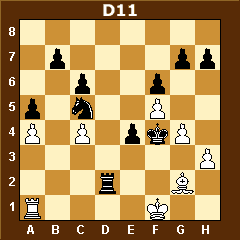 Alphonse:
I choose...none! I resigned instead. Alphonse:
I choose...none! I resigned instead.
Mig: Not early
I suppose, but there's no harm in forcing him to queen a pawn. It's a
simul, you never know what might happen. He might blunder. Plus, as long
as YOU are still thinking and working there is a reason to play on.
[37...Kf4 38.Kg1 e3 39.Rf1+ Ke5-+ 40.Bf3
Mig: White
would like to give up his bishop for the pawn and try to get his rook
active against the black pawns. 40...Nd3 41.Rd1 Kd4 42.Rb1 Kxc4]
Replay the game with annotations online
here.
|


















 Alterman
was certainly more than a match for me (Mig) during our office blitz matches.
I managed to pick up the rare win or draw against just about every other
titled player in the Israeli office blitz tournaments. But I don't remember
ever scoring against Deep Boris, a nickname he acquired from working with
the programmers of the Junior (and Deep Junior) computer program.
Alterman
was certainly more than a match for me (Mig) during our office blitz matches.
I managed to pick up the rare win or draw against just about every other
titled player in the Israeli office blitz tournaments. But I don't remember
ever scoring against Deep Boris, a nickname he acquired from working with
the programmers of the Junior (and Deep Junior) computer program.
 Alphonse:
As has been suggested, I spend barely any time on studying openings. Needless
to say, I did read Tony Kosten's "The Dynamic English" about
a year and a half ago and have played the English ever since.
Alphonse:
As has been suggested, I spend barely any time on studying openings. Needless
to say, I did read Tony Kosten's "The Dynamic English" about
a year and a half ago and have played the English ever since.  Alphonse:
Whoops! At the time, this seemed like a great move. I would get my center
pawn and even better, make my opponent waste time by moving his Knight
twice. This move looked so perfect in theory, that I didn't think twice
about it. Fritz points out the vicious tactic.
Alphonse:
Whoops! At the time, this seemed like a great move. I would get my center
pawn and even better, make my opponent waste time by moving his Knight
twice. This move looked so perfect in theory, that I didn't think twice
about it. Fritz points out the vicious tactic.  Alphonse:
Cool! Yet another opening move with tempo! Sure, he's not going to hang
the Bishop, but now he has to do something to protect it. Plus, I thought
I could now protect both d2 and e4.
Alphonse:
Cool! Yet another opening move with tempo! Sure, he's not going to hang
the Bishop, but now he has to do something to protect it. Plus, I thought
I could now protect both d2 and e4. Mig:
The GM is playing for a clear, simple advantage instead of worrying about
punishing White's mistakes immediately. This move prepares to capture
the knight, which is the only piece defending the key d4 square. After
he captures he will drop a knight on d4 with total domination.
Mig:
The GM is playing for a clear, simple advantage instead of worrying about
punishing White's mistakes immediately. This move prepares to capture
the knight, which is the only piece defending the key d4 square. After
he captures he will drop a knight on d4 with total domination. Mig:
Black has removed the weak white d-pawn, but has gained compensation.
After the exchanges White has been left with a miserable bishop on f3
that has little hope of ever living a full life. The pawns on c4 and e4
block its best diagonals.
Mig:
Black has removed the weak white d-pawn, but has gained compensation.
After the exchanges White has been left with a miserable bishop on f3
that has little hope of ever living a full life. The pawns on c4 and e4
block its best diagonals.  Alphonse:
Now I'm thinking about pressuring the Bishop as I noticed I could attack
him indirectly while at the same time developing mine. But, sorry to say,
I also didn't see any better place for him.
Alphonse:
Now I'm thinking about pressuring the Bishop as I noticed I could attack
him indirectly while at the same time developing mine. But, sorry to say,
I also didn't see any better place for him. Alphonse:
I really thought that this was not only the only place for my Queen, but
also a way to be able to make some sort of progress with Kh1 followed
by f2-f4.
Alphonse:
I really thought that this was not only the only place for my Queen, but
also a way to be able to make some sort of progress with Kh1 followed
by f2-f4. Alphonse:
Stupid...just stupid. I can't even blame this one on zeitnot or my kids
or my dogs howling in the background. I saw an immediate crisis taking
place on f2 and g2 and felt that breaking the pin along the g1-a7 diagonal
was more important than a pawn.
Alphonse:
Stupid...just stupid. I can't even blame this one on zeitnot or my kids
or my dogs howling in the background. I saw an immediate crisis taking
place on f2 and g2 and felt that breaking the pin along the g1-a7 diagonal
was more important than a pawn. Alphonse:
I thought I had to do something to challenge both Rooks coming at me on
the 2nd rank. Now, I wish I had taken advantage of the opportunity to
at least give my king a little play in case this game actually made it
as far as an endgame.
Alphonse:
I thought I had to do something to challenge both Rooks coming at me on
the 2nd rank. Now, I wish I had taken advantage of the opportunity to
at least give my king a little play in case this game actually made it
as far as an endgame.  Alphonse:
This is another move that seemed just fine to me. Granted, I'm lost, but
it appeared to me that either my Bishop went, or the f4-pawn went. If
I traded Queens, like Fritz wanted me to do, I expected a quick loss because
I'd have no fire-power and a passed pawn was not too far off for Black.
Alphonse:
This is another move that seemed just fine to me. Granted, I'm lost, but
it appeared to me that either my Bishop went, or the f4-pawn went. If
I traded Queens, like Fritz wanted me to do, I expected a quick loss because
I'd have no fire-power and a passed pawn was not too far off for Black.
 Alphonse:
I choose...none! I resigned instead.
Alphonse:
I choose...none! I resigned instead. 




